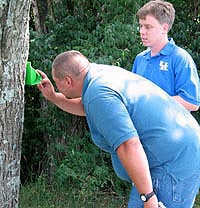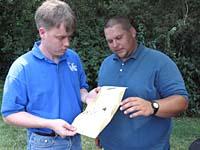Slow the Spread Program Monitors Gypsy Moth Progression
Slow the Spread Program Monitors Gypsy Moth Progression



Carl Harper holds a trap while J.D. Loan points out an adult male gypsy moth.
The gypsy moth, which can decimate hardwood populations in a few short years, is one of the most devastating forest pests in the eastern United States, according to the U.S. Department of Agriculture’s Forest Service. Since the hardwood industry is vital to Kentucky’s economy, it is important to make sure the moth doesn’t gain a foothold in the state.
Professionals in the University of Kentucky College of Agriculture are attempting to do just that. They are taking part in a federally funded project known as Slow the Spread (STS) as a proactive way of tracking the gypsy moth’s whereabouts and keeping it out of Kentucky forests. UK is cooperating with the USDA and the Kentucky Division of Forestry, as part of a complementary gypsy moth monitoring program, to set about 1,000 traps in several Kentucky counties that border the Ohio River.
“The idea is to try to keep it out of the state for as long as possible for the simple fact that it is an insect that can be very devastating,” said Carl Harper, UK College of Agriculture nursery inspector and STS project manager. “Since Kentucky forests are heavily populated with white oak, the gypsy moth’s favorite type of tree, over time it would change the ecology of the forest and could be devastating.”
J.D. Loan is the trapping manager for the STS project. He and his team place and monitor traps throughout the summer months and report their findings to a national database housed at Virginia Tech University. A pheromone attracts adult males, which are then caught in a sticky substance on the trap. All the traps are mapped to a specific location using GPS technology. In early August the traps are removed and final data for the season are recorded.
With STS data, scientists can see exactly where the line of suppression is for the gypsy moth. Over the years, the line slowly has moved south to a point where it now nearly borders Kentucky on the north and east.
“Depending on what the gypsy moth does, we could either see our lines move back or we could see the STS line move toward the Ohio River,” Loan said. “As the gypsy moth keeps spreading, then our lines could be going farther across the state, and it could cover the whole state eventually if the gypsy moth spreads the way we expect it to.”
Harper said some moths have been found in Kentucky but not enough to say the state has a problem.
“It’s really only the adult male we’re finding, so just one life stage,” he said. “When we find two life stages, for example a moth and egg mass, that’s when we’ll get concerned.”
Harper said it’s important to realize just how much of an impact the gypsy moth could have on the hardwood industry.
“The trees are totally gone, it’s not like the Japanese beetles where they skeletonize and only hit certain parts of the tree, like the upper canopy,” he said. “Gypsy moths go for the entire tree and they will completely defoliate the tree, down to where it looks like winter in the spring.”
Loan, who is from Greenup County, said the project is important to him because people in his area of the state depend on forestry for their livelihood.
“After two or three years of defoliation, the hardwoods would die because they couldn’t produce energy,” he said. “That would put loggers out of business. In eastern Kentucky a lot of the time, if you’re not in forestry, you’re driving somewhere else to go to work. That shows how important this project really is.”
If the moth is determined to be a problem in the Commonwealth, Harper said they would begin trying to “trap it out.” He said aggressive trapping could do the trick by halting the breeding cycle. If trapping doesn’t work, other control methods would be considered.
